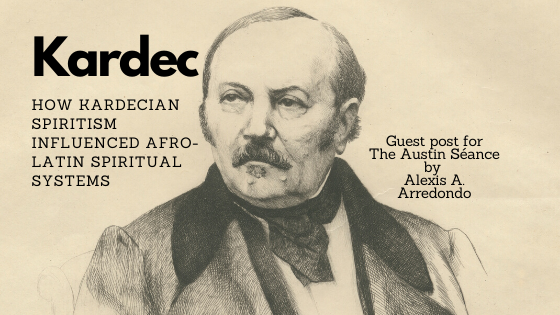by Alexis A. Arredondo
For The Austin Séance
In August of 2019, Netflix released the film Kardec, about Allan Kardec, the mid-nineteenth century founder of modern day Spiritism. His most famous work, The Spirits Book (1857), was translated widely from the original French and published both in the Americas and Europe. It also led to the spread of Kardecian Spiritism in such places as Cuba, Haiti, Brazil and elsewhere throughout the Americas. There, his Spiritism mixed with the traditional religious practices of imported slaves and regional Roman Catholicism to form entirely new Afro-Latin spiritual systems.

Allen Kardec — actually a pen name for “Hippolyte Léon Denizard Rivail” — was born on Oct. 3, 1804, in Lyon, France, and raised Roman Catholic. He was a man of letters, having received instruction in both philosophy and the sciences, as well as a doctorate in medicine. He could speak at least four languages fluently in addition to his native French and he was a member of several scholarly societies. During the 1850s Kardec became fascinated with séances and mediumship which resulted in his own investigation of psychic phenomena. This in turn led to the creation of his philosophy of “Spiritism” as well as the publication of five works known as the “Spiritist Codification.”
Spiritism vs Spiritualism
Kardec initially defined “Spiritism” as “a science that deals with the nature, origin, and destiny of spirits, and their relation with the corporeal world.” In contrast to the more fluid idea of spiritualism often referenced on this website, Kardecian Spiritism states that there is one supreme God and that when we die, our spirit lives on to help others until it is time for our next incarnation. Spiritism teaches that enlightened spirits help guide followers on their path, but malevolent spirits also exist and can attach their negative forces upon them, creating heightened tension, violence and fear. Similar to more traditional spiritualist practices, Kardec also states that mediums have the ability  to manifest spirits within themselves through physical or trance mediumship.
to manifest spirits within themselves through physical or trance mediumship.
History shows us that the African slaves held onto their religious practices in Roman Catholic Latin America by hiding their traditional gods behind saints or powerful holy spirits. Allan Kardec’s thought then exerted its own influence in Latin America, and his teachings both mirrored traditional African practices and reinforced them. For example, in Cuba a religious tradition known as “Espiritismo” (Spanish for “spiritism”) is popular. This is nothing more than the actual practice of Kardecian Spiritism. But these practices then mixed further to create Espiritismo Cruzado (crossed or mixed spiritism) that keeps the basic outline of Kardec, but immerses the Congo-Cuban influence to call forward spirits of the past, such as slave and native spirits. Espiritismo Cruzado employs stylized masses known as the misa (mass) or mesa blanca (white table) that still are widely practiced among adherents of Cuban Santeria (Nigerian Orisha worship) and Palo Mayombe. Kardec glass spiritual candles can still be found at almost any Afro-Latin botanica or spiritual shop, complete with a prayer on the back for divine communication.
Kardec’s influence is so strong in Brazil that it led to the production of the 2019 Netflix film that I referenced above. In south Brazil, a similar practice to Espiritismo Cruzado would also emerge with the birth of two new religions originating from the Afro-Brazilian practice of Macumba. The Nigerian Orisa-influenced Spiritism (spelled Orixa in Brazil), is called Umbanda and its Congolese-influenced counterpart was named Kimbanda. Each of these traditions has its own form of spiritual mass similar to the Cuban misa. Spiritism is so prevalent in Brazil, that spiritist hospitals exist to help cure patients who believe that they are suffering from the influence of negative spirits. Kardec’s own image appears in Umbanda as a plaster bust often found on their Gongas, or altars.
These influences are predominantly seen in Brazil and Cuba, but they can be found in other Afro-Latin and Afro-Carribean practices as well, such as in Vodou of Haiti, in Sanse of Puerto Rico, in 21 Divisions of Dominican Republic, in Obeah of Jamaica and the Maria Lionza cult of Venezuela.
It’s clear that without Kardec’s writings, many of these new Afro-Latin traditions would have developed far differently — and almost certainly without the heavy influence of spiritualist-like practices. New World religious practitioners embraced Kardec’s teachings, mixed those with heavy doses of Roman Catholicism and African belief systems, and in the process they created dozens of distinct and vibrant religious forms that continue flourishing in the Americas even to this day.
